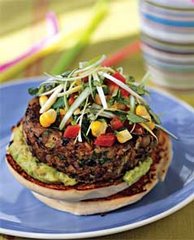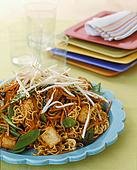My seven year old is a vegetarian. When she started her quest of avoiding meat we thought just cutting out meat itself would be enough, but it has become a journey of shocking, jaw-dropping discovery at just what contains ground-up animal parts. As a result, I am now a veggie. So I have gone from researching good recipes and nutritional information, which is essential for such a young vegetarian, to the family taking on a healthier, more compassionate outlook on life.
Thursday, 26 April 2007
The magic of hemp!
Linda McCartney believed that vegetarian cooking was better for the environment.
This got me thinking, if we gave up eating cows there would be less cows (farmers wouldn‘t keep them for the fun of it) and as cows are renowned for their production of methane then less cows equals less methane. All very good for the environment.
Not that I am advocating the loss of cows altogether, don’t get me wrong, I love cows, that’s why I don’t eat them!
Looking at it from an eco point of view, we should also think about where our clothing comes from, as the manufacture of rubber produces a toxic waste, we should perhaps stop wearing the rubber!
As a recent convert to vegetarianism and with light being shed on some clothing nasties i.e. the collection of wool and cashmere, I am choosing to avoid them. However, if I don’t want to wear animals in one form or another and I don’t want to pollute the planet, it is getting hard to find anything to wear, and although being a vegetarian is helping me to slim (a bit) I am nowhere near ready to saunter down the high street in the nude!
This is a minefield:
Cotton
Cotton is, of course, a plant product but there are various environmental considerations to be taken into account, like the heavy use of pesticides, dyes and other chemicals in the finishing process causing pollution. Cotton represents 5% of the world's agriculture and uses 50% of the world's insecticides. DDT is still used in the developing world where it is often too hot for the correct protective clothing to be worn. Instances of poisoning by insecticides are probably higher than reported. (Figures from The Guardian 29.10.90).
Linen
Linen is also a vegetable product, being derived from the Flax plant. Flax is one of the world's oldest cultivated plants. The fibres are extracted from the plant by a process called retting, there is a chemical retting method which is faster but more harmful to the environment.
Rayon
The raw material for rayon is eucalyptus trees, but it requires chlorine in the early stages of production, which in turn causes pollution by organo-chlorine compounds including dioxin.
Synthetics
Synthetic materials are usually oil-based with about 25 thousand barrels of oil a day being used to manufacture materials. Oil is a non-renewable resource and the petro-chemical industry can cause serious pollution. Synthetics are not biodegradable. The production of nylon leads to large quantities of nitrous oxide being emitted. Nitrous oxide is one of the gases responsible for the greenhouse effect.
I feel a streak (not steak) coming on! But before I go out in the street and frighten the horses, take heart, there is hope, HEMP. Anything cotton can do, hemp can do better (the industrial, not the smoking kind) and it is much easier to grow, more resilient to pests, so much, much better for the environment.
This got me thinking, if we gave up eating cows there would be less cows (farmers wouldn‘t keep them for the fun of it) and as cows are renowned for their production of methane then less cows equals less methane. All very good for the environment.
Not that I am advocating the loss of cows altogether, don’t get me wrong, I love cows, that’s why I don’t eat them!
Looking at it from an eco point of view, we should also think about where our clothing comes from, as the manufacture of rubber produces a toxic waste, we should perhaps stop wearing the rubber!
As a recent convert to vegetarianism and with light being shed on some clothing nasties i.e. the collection of wool and cashmere, I am choosing to avoid them. However, if I don’t want to wear animals in one form or another and I don’t want to pollute the planet, it is getting hard to find anything to wear, and although being a vegetarian is helping me to slim (a bit) I am nowhere near ready to saunter down the high street in the nude!
This is a minefield:
Cotton
Cotton is, of course, a plant product but there are various environmental considerations to be taken into account, like the heavy use of pesticides, dyes and other chemicals in the finishing process causing pollution. Cotton represents 5% of the world's agriculture and uses 50% of the world's insecticides. DDT is still used in the developing world where it is often too hot for the correct protective clothing to be worn. Instances of poisoning by insecticides are probably higher than reported. (Figures from The Guardian 29.10.90).
Linen
Linen is also a vegetable product, being derived from the Flax plant. Flax is one of the world's oldest cultivated plants. The fibres are extracted from the plant by a process called retting, there is a chemical retting method which is faster but more harmful to the environment.
Rayon
The raw material for rayon is eucalyptus trees, but it requires chlorine in the early stages of production, which in turn causes pollution by organo-chlorine compounds including dioxin.
Synthetics
Synthetic materials are usually oil-based with about 25 thousand barrels of oil a day being used to manufacture materials. Oil is a non-renewable resource and the petro-chemical industry can cause serious pollution. Synthetics are not biodegradable. The production of nylon leads to large quantities of nitrous oxide being emitted. Nitrous oxide is one of the gases responsible for the greenhouse effect.
I feel a streak (not steak) coming on! But before I go out in the street and frighten the horses, take heart, there is hope, HEMP. Anything cotton can do, hemp can do better (the industrial, not the smoking kind) and it is much easier to grow, more resilient to pests, so much, much better for the environment.
Subscribe to:
Post Comments (Atom)
































No comments:
Post a Comment